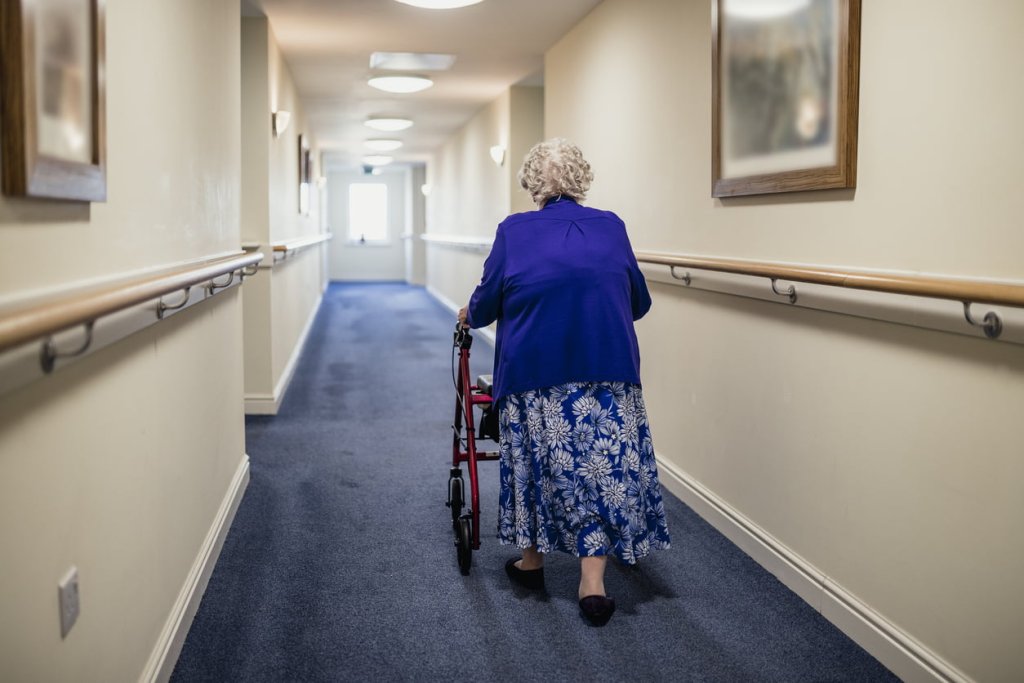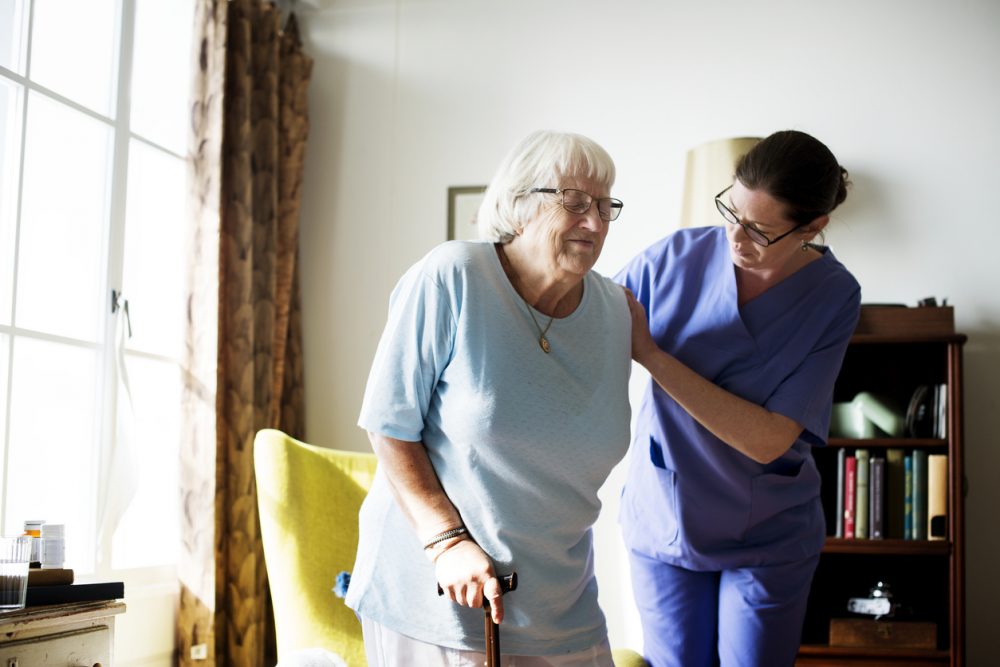In this blog for nurses, Helen Cowan reflects on the latest Cochrane evidenceCochrane Reviews are systematic reviews. In systematic reviews we search for and summarize studies that answer a specific research question (e.g. is paracetamol effective and safe for treating back pain?). The studies are identified, assessed, and summarized by using a systematic and predefined approach. They inform recommendations for healthcare and research. on falls preventions in care homes and hospitals and reflects in the context of her nursing practice.
As a nurse, I spend a lot of time on my knees. Not in prayer for increased staffing or respite from the relentless workload, but in ministering to the fallen patient, checking them for injury, comforting them in their distress and making a plan as to how to get them vertical again (or at least into a chair). I’ve sought out sensor mats and crash mats, used low beds and bedrails and even nursed patients individually in something known as ‘specialing’ to try to prevent falls and falls-related injuries.
Falls though remain a major public health problem according to the World Health Organization with numbers reaching epidemic proportions. An estimated 646,000 individuals die from falls globally each year, whilst approximately 37.3 million falls are severe enough to require medical attention (World Health Organization, 2018). Falls are estimated to cost the NHS more than £2.3 billion each year (NICE, 2013).

More than 400 separate riskA way of expressing the chance of an event taking place, expressed as the number of events divided by the total number of observations or people. It can be stated as ‘the chance of falling were one in four’ (1/4 = 25%). This measure is good no matter the incidence of events i.e. common or infrequent. factors for falls have been identified and they include cognitive impairment, continence problems, falls history including causes and consequences (such as injury and fear of falling), footwear that is unsuitable or missing, health problems that may increase the risk of falling, medication, postural instability, mobility problems and/or balance problems, syncope syndrome, visual impairment (NICE, 2013). It’s not surprising then that age is one of the key risk factors for falling, with 30% of people over the age of 65 falling at least once each year, and this number increases to 50% for those aged over 80 (NICE, 2013).
A recent Cochrane Review focused on falls prevention in older people, concentrating on care homes and hospitals (Cameron, 2018). How would the evidence inform my practice? Are current falls prevention strategies – including the use of falls risk assessment tools – effective?
Falls prevention in care homes and hospitals
For many nurses (including myself), this begins with the use of one of a number of validated falls risk assessment tools. Risk factors such as falls history, poor mobility, acute illnessA health condition (or episodes of a health condition) that comes on quickly and is short-lived., visual impairment, urinary incontinence, environmental hazards and polypharmacy are added up and a score given to suggest risk of falling. Medication review, use of sensor mats, low height beds or referral to the optician are among the measures then taken. Falls, however, still feature and I have sometimes wondered whether we are doing the right things: my own grandad used to try to jump over the bedside sensor mat to avoid the pesky alarm sounding; he sometimes slipped as he landed.

The authors of a Cochrane Review on preventing healthcare bed-related injuries state that “the effectivenessThe ability of an intervention (for example a drug, surgery, or exercise) to produce a desired effect, such as reduce symptoms. of interventions designed to prevent patient injuries from their beds (including bed rails, low height beds and bed exit alarms) remains uncertain.”(Anderson et al, 2012).
The recently updated Cochrane ReviewCochrane Reviews are systematic reviews. In systematic reviews we search for and summarize studies that answer a specific research question (e.g. is paracetamol effective and safe for treating back pain?). The studies are identified, assessed, and summarized by using a systematic and predefined approach. They inform recommendations for healthcare and research. assessing the effects of a wider range of interventions aimed at preventing falls in older people in care homes and hospitals (Cameron, 2018), included 35 new trialsClinical trials are research studies involving people who use healthcare services. They often compare a new or different treatment with the best treatment currently available. This is to test whether the new or different treatment is safe, effective and any better than what is currently used. No matter how promising a new treatment may appear during tests in a laboratory, it must go through clinical trials before its benefits and risks can really be known. bringing the total number of trials to 95 (138,164 participants). 71 of the trials were in care facilities (40,374 participants; mean age 84 years; 75% women) and 24 trials were in hospitals (97,790 participants; mean age 78 years; 52% women).
The review authors conclude that, in care homes, exercise and general medication review may make little or no difference to the risk of falling; prescription of vitamin D probably makes little or no difference to the risk of falling. Uncertainty surrounds the use of sensor mats, staff training by specialist osteoporosis nurses, and more unusual interventions such as “lavender olfactory stimulation, multisensory stimulation in a ‘Snoezelen room’ or sunlight exposure” – since the evidence is of very low quality.
The authors also remain uncertain about the effects of physiotherapy, medication review, vitamin D supplementation or bed sensor alarms on the rateThe speed or frequency of occurrence of an event, usually expressed with respect to time. For instance, a mortality rate might be the number of deaths per year, per 100,000 people. or risk of falling in hospitals, since the evidence is of very low quality.
Reconsidering risk assessment
For me, the most interesting finding was that use of the falls risk assessment tool (something that I spend a lot of time completing) in comparison with nurses’ judgement alone probably makes little or no difference to the rate of falls or risk of falling in care homes; the authors also cite a lack of evidence on whether or not falls risk assessments reduce falls in hospitals. Could it be that nurses’ time is better spent with patients? The wide use of these tools internationally is questioned in the Cochrane Review and further trials examining the effectiveness of the tools are called for (Cameron et al, 2018). Meanwhile, the lack of reliable evidence on the use of pressure ulcer risk assessment tools has been carefully considered in another Evidently Cochrane blog (Chapman, 2014).
Where does this leave us nurses?
Of course, whatever the state of the evidence, clinical decisions have to be made. A recent blog reminds us that evidence-based medicine comprises three components: the evidence itself, the patient’s preferences and values, and clinical judgement (Byatt and Chapman, 2018). When the evidence is inconclusive, the other elements will have to come to the fore, while other factors such as the availability of resources may limit the choices. Nurses Shannon Deakin and Teresa Chinn reflect on this in relation to caring for people with incontinence in this blog (Chapman et al, 2016.)
We can also keep an eye on the Cochrane Library. Reviews are periodically updated, so we can check if recent evidence has been added and shown whether a practice is effective and safe.
Recruitment and retention of nurses may also be key: the number of district nurses has plummeted by 44% since 2010 (Brindle, 2017); NHS England is short of 40,000 nursing staff in hospitals (Gallagher, 2018); falls risk may vary with nurse staffing levels and skill mix (He et al, 2016). I’ve seen overstretched staff unable to reach unsteady patients before they fall, as they try to toilet themselves or reach for dropped possessions when help is delayed.
Supporting the fallers
Sadly bruises, strains, sprains, hip fractures and even haemorrhage can result from a fall; the mental health effects of a fall also deserve a mention: fear of falling and loss of confidence often follow. Falls prevention remains a priority in research.
Meanwhile, I’ve been surprised to see that experiencing a fall can also, just sometimes, be the catalyst for positive change: a change in the self (more accepting of one’s vulnerabilities) and a change in relationships (with people experiencing a greater need for connection and feeling closer to others) (Akhtar, 2017). The poet Elizabeth Jennings marveled at a tenderness she had not experienced before when laid low in a hospital bed (Jennings, 2001 from Mason, 2012). Independence is an illusion anyway: we are all a lot more interconnected and dependent on each other than we think. Falls bring this sharply into focus, and whilst we remain unable to eliminate them, it is important to see something positive emerge from the negative experience if we can. Compassionate nursing care of the fallen patient can achieve just that.
Editor’s note: the Cochrane Library has published a Special Collection: Preventing falls and fall-related injuries in older people.
Join in the conversation on Twitter with @HelenCCowan @CochraneUK or leave a comment on the blog.


